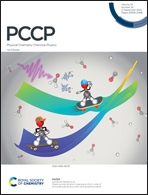Temperature-driven phase transition of Ti2CN from first-principles calculations†
Abstract
First-principles evolutionary simulations are used to predict the stable compound of Ti2CN. Body-centered tetragonal I41/amd-Ti2CN is found to be more energetically favorable than the other Ti2CN compounds at 0 K. The phase stability as a function of temperature for all relevant competing Ti2CN phases is investigated by means of first-principles calculations and quasi-harmonic approximation. Our calculations predict that I41/amd-Ti2CN undergoes a phase transition to P42/mmc at 1698 K and then to R![[3 with combining macron]](https://www.rsc.org/images/entities/char_0033_0304.gif) m at 1872 K. The different effects from the harmonic, electronic and quasi-harmonic contributions to the Gibbs free energy for I41/amd, P42/mmc and R
m at 1872 K. The different effects from the harmonic, electronic and quasi-harmonic contributions to the Gibbs free energy for I41/amd, P42/mmc and R![[3 with combining macron]](https://www.rsc.org/images/entities/char_0033_0304.gif) m phases are compared and analyzed. It is found that both the electronic and quasi-harmonic contributions to the Gibbs free energies significantly affect the phase transition curve of Ti2CN. The calculated temperature-dependent lattice parameter is carefully compared with the previous experimental results. We also provide important thermodynamic quantities as the volumetric expansion coefficient and isothermal bulk modulus and discuss their temperature dependence.
m phases are compared and analyzed. It is found that both the electronic and quasi-harmonic contributions to the Gibbs free energies significantly affect the phase transition curve of Ti2CN. The calculated temperature-dependent lattice parameter is carefully compared with the previous experimental results. We also provide important thermodynamic quantities as the volumetric expansion coefficient and isothermal bulk modulus and discuss their temperature dependence.

- This article is part of the themed collection: 2022 PCCP HOT Articles


 Please wait while we load your content...
Please wait while we load your content...